|
| | |
|
A Lovecraft Comic Book Cover Gallery V:
The Music of Erich Zann +
(Jones et al., 1993) |
|
| | |
|
|
|
This is the fifth installment in our Lovecraft themed cover galleries. Below, we present covers from The Music of Erich Zann and other stories adapted by Steven Phillip Jones, illustrated by various artists and published in the United States by Caliber Press.
|
|
|
| | |
|
|
|
1

- title: The Worlds of H.P. Lovecraft: The Music of Erich Zann
- publisher: Caliber Press
- cover artist: Aldin Baroza
- writer (adaptation): Steven Phillip Jones
- artist: Aldin Baroza
- issue: #01 of 10
- release date: 1993
- cover: A cover
- format: standard comic
- excerpt:
I have examined maps of the city with the greatest care, yet have never again found the Rue d'Auseil. These maps have not been modern maps alone, for I know that names change. I have, on the contrary, delved deeply into all the antiquities of the place, and have personally explored every region, of whatever name, which could possibly answer to the street I knew as the Rue d'Auseil. But despite all I have done, it remains an humiliating fact that I cannot find the house, the street, or even the locality, where, during the last months of my impoverished life as a student of metaphysics at the university, I heard the music of Erich Zann.
—The Music of Erich Zann, H.P. Lovecraft (1921) (full text)
|
|
|
| | |
|
|
|
2

- title: The Worlds of H.P. Lovecraft: The Picture in the House
- publisher: Caliber Press
- cover artist: Rob Davis
- writer (adaptation): Steven Phillip Jones
- artist: Rob Davis
- issue: #02 of 10
- release date: 1993
- cover: A cover
- format: standard comic
- excerpt:
Searchers after horror haunt strange, far places. For them are the catacombs of Ptolemais, and the carven mausolea of the nightmare countries. They climb to the moonlit towers of ruined Rhine castles, and falter down black cobwebbed steps beneath the scattered stones of forgotten cities in Asia. The haunted wood and the desolate mountain are their shrines, and they linger around the sinister monoliths on uninhabited islands. But the true epicure in the terrible, to whom a new thrill of unutterable ghastliness is the chief end and justification of existence, esteems most of all the ancient, lonely farmhouses of backwoods New England; for there the dark elements of strength, solitude, grotesqueness and ignorance combine to form the perfection of the hideous.
Most horrible of all sights are the little unpainted wooden houses remote from travelled ways, usually squatted upon some damp grassy slope or leaning against some gigantic outcropping of rock. Two hundred years and more they have leaned or squatted there, while the vines have crawled and the trees have swelled and spread. They are almost hidden now in lawless luxuriances of green and guardian shrouds of shadow; but the small-paned windows still stare shockingly, as if blinking through a lethal stupor which wards off madness by dulling the memory of unutterable things.
In such houses have dwelt generations of strange people, whose like the world has never seen. Seized with a gloomy and fanatical belief which exiled them from their kind, their ancestors sought the wilderness for freedom. There the scions of a conquering race indeed flourished free from the restrictions of their fellows, but cowered in an appalling slavery to the dismal phantasms of their own minds. Divorced from the enlightenment of civilization, the strength of these Puritans turned into singular channels; and in their isolation, morbid self-repression, and struggle for life with relentless Nature, there came to them dark furtive traits from the prehistoric depths of their cold Northern heritage. By necessity practical and by philosophy stern, these folks were not beautiful in their sins. Erring as all mortals must, they were forced by their rigid code to seek concealment above all else; so that they came to use less and less taste in what they concealed. Only the silent, sleepy, staring houses in the backwoods can tell all that has lain hidden since the early days, and they are not communicative, being loath to shake off the drowsiness which helps them forget. Sometimes one feels that it would be merciful to tear down these houses, for they must often dream.
—The Picture in the House, H.P. Lovecraft (1919) (full text)
|
|
|
| | |
|
|
|
3
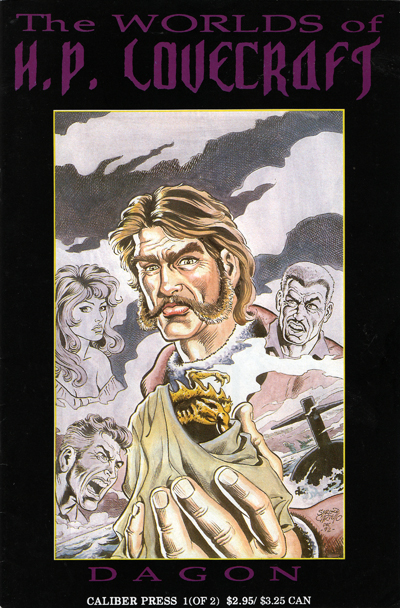
- title: The Worlds of H.P. Lovecraft: Dagon
- publisher: Caliber Press
- cover artist: Sergio Cariello
- writer (adaptation): Steven Phillip Jones
- artist: Sergio Cariello
- issue: #03 of 10
- release date: June, 1993
- cover: A cover
- format: standard comic
- excerpt:
I am writing this under an appreciable mental strain, since by tonight I shall be no more. Penniless, and at the end of my supply of the drug which alone, makes life endurable, I can bear the torture no longer; and shall cast myself from this garret window into the squalid street below. Do not think from my slavery to morphine that I am a weakling or a degenerate. When you have read these hastily scrawled pages you may guess, though never fully realise, why it is that I must have forgetfulness or death.
It was in one of the most open and least frequented parts of the broad Pacific that the packet of which I was supercargo fell a victim to the German sea-raider. The great war was then at its very beginning, and the ocean forces of the Hun had not completely sunk to their later degradation; so that our vessel was made a legitimate prize, whilst we of her crew were treated with all the fairness and consideration due us as naval prisoners. So liberal, indeed, was the discipline of our captors, that five days after we were taken I managed to escape alone in a small boat with water and provisions for a good length of time.
When I finally found myself adrift and free, I had but little idea of my surroundings. Never a competent navigator, I could only guess vaguely by the sun and stars that I was somewhat south of the equator. Of the longitude I knew nothing, and no island or coastline was in sight. The weather kept fair, and for uncounted days I drifted aimlessly beneath the scorching sun; waiting either for some passing ship, or to be cast on the shores of some habitable land. But neither ship nor land appeared, and I began to despair in my solitude upon the heaving vastness of unbroken blue.
—Dagon, H.P. Lovecraft (1917) (full text)
|
|
|
| | |
|
|
|
4
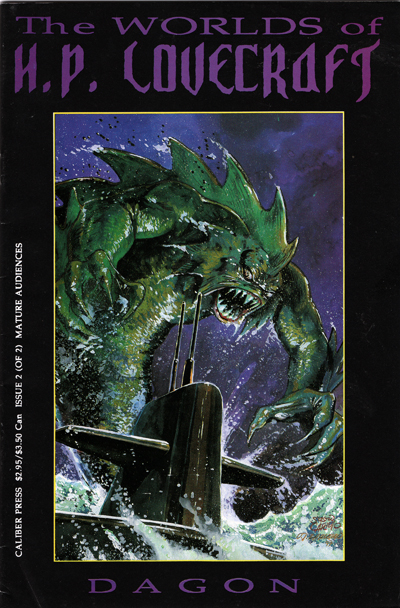
- title: The Worlds of H.P. Lovecraft: Dagon
- publisher: Caliber Press
- cover artist: Sergio Cariello
- writer (adaptation): Steven Phillip Jones
- artist: Sergio Cariello
- issue: #04 of 10
- release date: July, 1993
- cover: A cover
- format: standard comic
- commentary: Dagon was written in July, 1917 and was first published in November, 1919 in The Vagrant. Of the adaptations of Lovecraft's stories on this page, only Dagon ran two issues. The rest were one-shots.
|
|
|
| | |
|
|
|
5
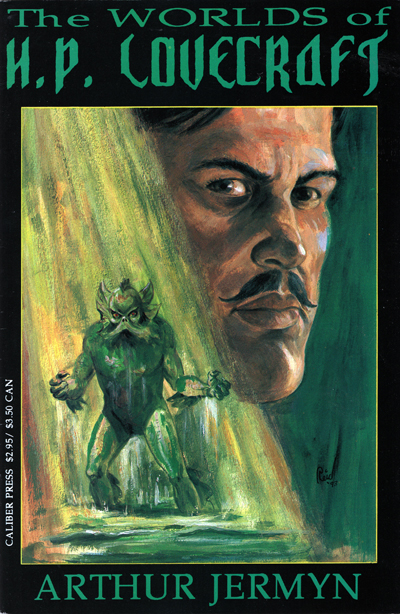
- title: The Worlds of H.P. Lovecraft: Arthur Jermyn
- publisher: Caliber Press
- cover artist: Wayne Reid
- writer (adaptation): Steven Phillip Jones
- artist: Wayne Reid
- issue: #05 of 10
- release date: 1993
- cover: A cover
- format: standard comic
- excerpt:
Life is a hideous thing, and from the background behind what we know of it peer daemoniacal hints of truth which make it sometimes a thousandfold more hideous. Science, already oppressive with its shocking revelations, will perhaps be the ultimate exterminator of our human species—if separate species we be—for its reserve of unguessed horrors could never be borne by mortal brains if loosed upon the world. If we knew what we are, we should do as Sir Arthur Jermyn did; and Arthur Jermyn soaked himself in oil and set fire to his clothing one night. No one placed the charred fragments in an urn or set a memorial to him who had been; for certain papers and a certain boxed object were found which made men wish to forget. Some who knew him do not admit that he ever existed.
—Facts Concerning the Late Arthur Jermyn and His Family, H.P. Lovecraft (1920) (full text)
|
|
|
| | |
|
|
|
6
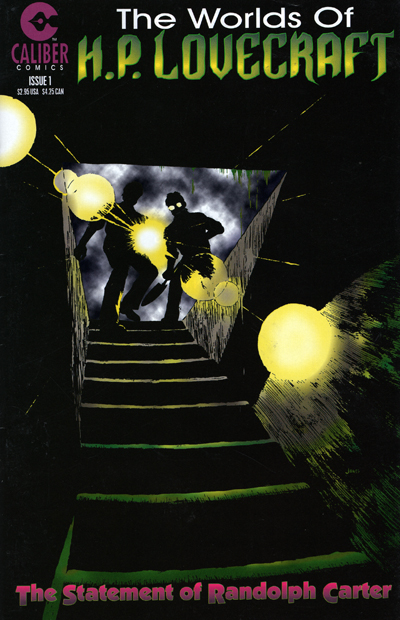
- title: The Worlds of H.P. Lovecraft: The Statement of Randolph Carter
- publisher: Caliber Press
- cover artist: Chris Jones
- writer (adaptation): Steven Phillip Jones
- artist: Chris Jones
- issue: #06 of 10
- release date: 1996
- cover: A cover
- format: standard comic
- excerpt:
Again I say, I do not know what has become of Harley Warren, though I think--almost hope--that he is in peaceful oblivion, if there be anywhere so blessed a thing. It is true that I have for five years been his closest friend, and a partial sharer of his terrible researches into the unknown. I will not deny, though my memory is uncertain and indistinct, that this witness of yours may have seen us together as he says, on the Gainsville pike, walking toward Big Cypress Swamp, at half past 11 on that awful night. That we bore electric lanterns, spades, and a curious coil of wire with attached instruments, I will even affirm; for these things all played a part in the single hideous scene which remains burned into my shaken recollection. But of what followed, and of the reason I was found alone and dazed on the edge of the swamp next morning, I must insist that I know nothing save what I have told you over and over again. You say to me that there is nothing in the swamp or near it which could form the setting of that frightful episode. I reply that I knew nothing beyond what I saw. Vision or nightmare it may have been--vision or nightmare I fervently hope it was--yet it is all that my mind retains of what took place in those shocking hours after we left the sight of men. And why Harley Warren did not return, he or his shade--or some nameless thing I cannot describe--alone can tell.
—The Statement of Randolph Carter, H.P. Lovecraft (1919) (full text)
|
|
|
| | |
|
|
|
7
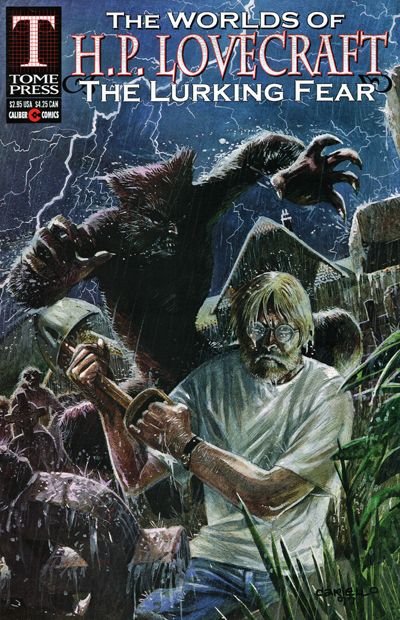
- title: The Worlds of H.P. Lovecraft: The Lurking Fear
- publisher: Tome Press/Caliber Press
- cover artist: Octavio Cariello
- writer (adaptation): Steven Phillip Jones
- artist: Octavio Cariello
- issue: #07 of 10
- release date: 1997
- cover: A cover
- format: standard comic
- commentary: This book is a black and white reissue of The Lurking Fear, which was originally published in full color by Adventure Comics (link) in 1991. The reissue has a new cover created by the interior artist, Octavio Cariello.
|
|
|
| | |
|
|
|
8
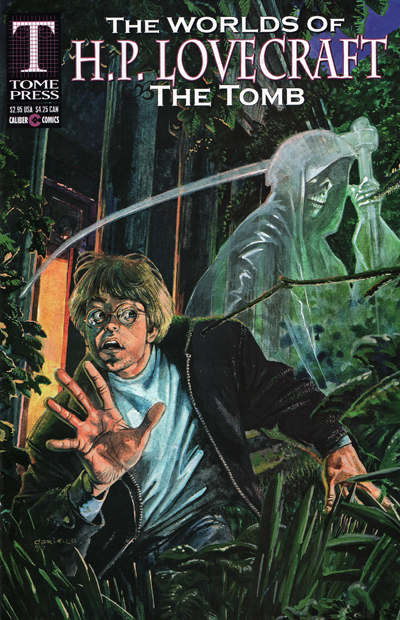
- title: The Worlds of H.P. Lovecraft: The Tomb
- publisher: Tome Press/Caliber Press
- cover artist: Octavio Cariello
- writer (adaptation): Steven Phillip Jones
- artist: Octavio Cariello
- issue: #08 of 10
- release date: 1997
- cover: A cover
- format: standard comic
- commentary: This book is a black and white reissue of The Tomb, which was originally published in full color by Adventure Comics (link) in 1992. The reissue has a new cover created by the interior artist, Octavio Cariello.
|
|
|
| | |
|
|
|
9
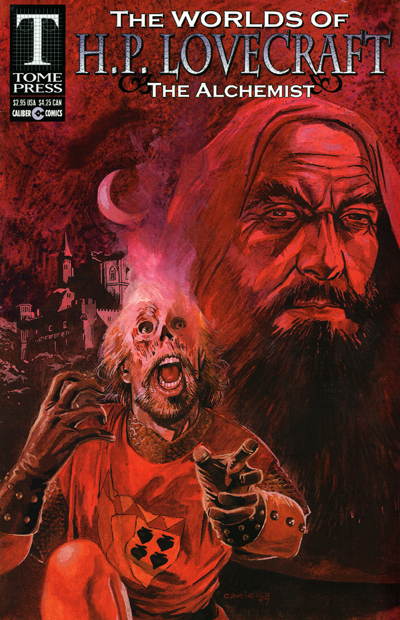
- title: The Worlds of H.P. Lovecraft: The Alchemist
- publisher: Tome Press/Caliber Press
- cover artist: Octavio Cariello
- writer (adaptation): Steven Phillip Jones
- artist: Octavio Cariello
- issue: #09 of 10
- release date: 1997
- cover: A cover
- format: standard comic
- commentary: This book is a black and white reissue of The Alchemist, which was originally published in full color by Adventure Comics (link) in 1992. The reissue has a new cover created by the interior artist, Octavio Cariello.
|
|
|
| | |
|
|
|
10
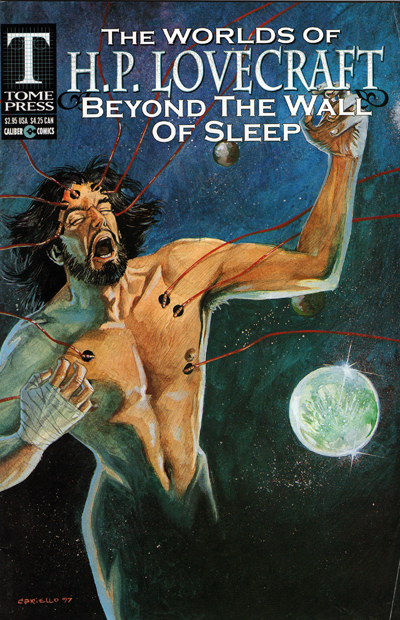
- title: The Worlds of H.P. Lovecraft: Beyond the Wall of Sleep
- publisher: Tome Press/Caliber Press
- cover artist: Octavio Cariello
- writer (adaptation): Steven Phillip Jones
- artist: Octavio Cariello
- issue: #10 of 10
- release date: 1998
- cover: A cover
- format: standard comic
- commentary: This book is a black and white reissue of Beyond the Wall of Sleep, which was originally published in full color by Adventure Comics (link) in 1992. The reissue has a new cover created by the interior artist, Octavio Cariello.
|
|
|
| | |
|
|
| more galleries |
|
|
| | |
|
|